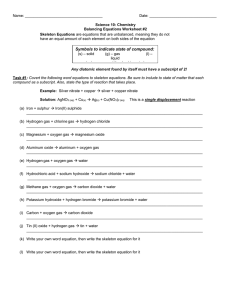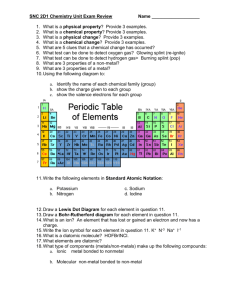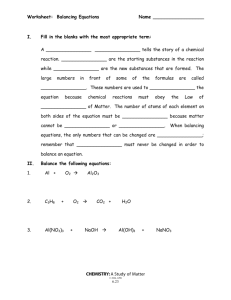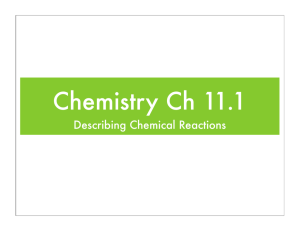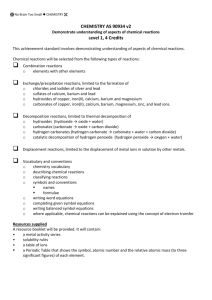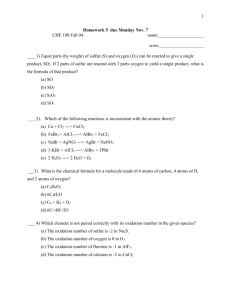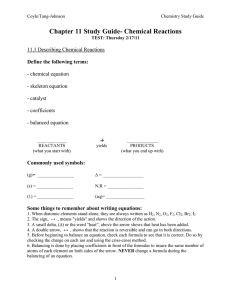Homework_1_12
advertisement
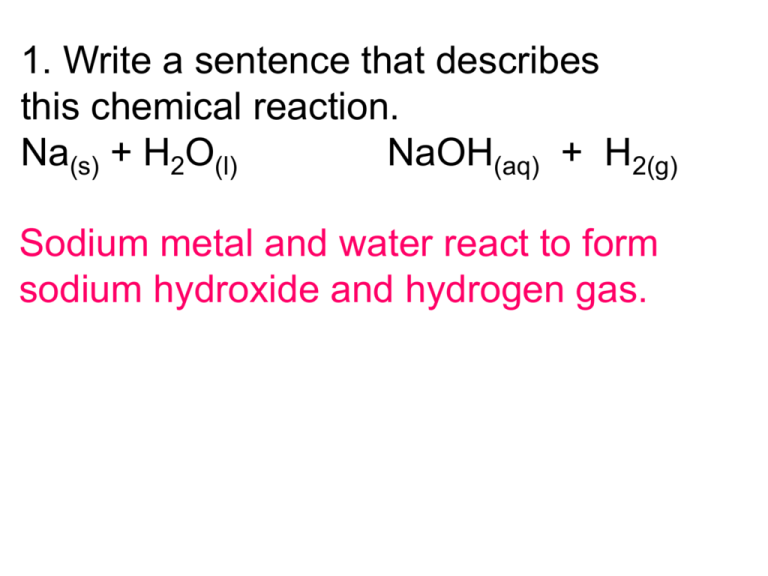
1. Write a sentence that describes this chemical reaction. Na(s) + H2O(l) NaOH(aq) + H2(g) Sodium metal and water react to form sodium hydroxide and hydrogen gas. 2. Sulfur burns in oxygen to form sulfur dioxide. Write a skeleton equation for this chemical reaction. Include appropriate symbols from table 11.1. S(s) + O2(g) SO2(g) #3 Balance each equation. a.2AgNO3 + H2S First try balancing the silver, Then balance the hydrogen Balanced! On each side: 2 Ag 2 NO3 2H 1S Ag2S + 2HNO3 #3 Balance each equation. b.3 Zn(OH)2 + 2 H3PO4 First try balancing the zinc, Then balance the PO4 then balance the hydrogen Balanced! On each side: 3 Zn 2 PO4 12 H 6O Zn3(PO4)2 +6 H2O 4. Rewrite these word equations as balanced chemical equations. a. hydrogen + sulfur H2 (g) + S(s) hydrogen sulfide H2S(g) b. iron (III) chloride + calcium hydroxide iron (III) hydroxide + calcium chloride 2 FeCl3 + 3 Ca(OH)2 2 Fe(OH)3 + 3CaCl2 #5 Balance each equation: a. FeCl3 + 3 NaOH b. CS2 + 3 Cl2 Fe(OH)3 + 3 NaCl CCl4 + S2Cl2 #6 Write and balance this equation: calcium hydroxide + sulfuric acid Ca(OH)2 + H2SO4 calcium sulfate + water CaSO4 + 2 H2O #7 Key Concept How do you write a word equation? calcium hydroxide + sulfuric acid calcium sulfate + water To write a word equation you need to include the names of the reactants (left) and products (right) on either side of an arrow showing the direction of the reaction. #8 Key Concept How do you write a skeleton equation? Ca(OH)2 + H2SO4 CaSO4 + H2O To write a skeleton equation you need to include the correct formulas for the the reactants (left) and products (right) of an arrow showing the direction of the reaction. This is NOT BALANCED YET #9 Key Concept Describe the steps in writing a balanced chemical equation. Ca(OH)2 + H2SO4 CaSO4 + 2 H2O 1. Write out the correct formulas for each compound in the reaction on both sides of an arrow. 2. Add coefficients when needed in FRONT of the compounds to give the same # and types of elements on both sides of the equation. #10. Write skeleton equations for these reactions: a. Heating copper (II) sulfide in the presence of diatomic oxygen produces pure copper and sulfur dioxide gas. CuS(s) + O2(g) ∆ Cu(s) + SO2 (g) b. When heated, baking soda (sodium hydrogen carbonate) decomposes to form the products sodium carbonate, carbon dioxide, and water. ∆ NaHCO3 (s) Na2CO3(s) + CO2 (g) + H2O(g) #11 Write and balance equations for the following reactions: Iron metal and chlorine gas react to form solid iron (III) Chloride. ∆ a. 2 Fes) + 3 Cl2(g) 2 FeCl3(s) Solid aluminum carbonate decomposes to form solid aluminum oxide and carbon dioxide gas. b. Al2(CO3)3 (s) ∆ Al2O3 + 3 CO2(g) #11 Write and balance equations for the following reactions: Solid magnesium reacts with aqueous silver nitrate to form silver and aqueous magnesium c. Mg(s) + 2AgNO3(aq) 2 Ag(s) + Mg(NO3)2(s) #12 Write and balance equations for the following reactions: a. 2 SO2(s) + O2(g) b. Fe2O3 (s) + 3H2(g) c. 4 P(s) + 5 O2(g) d. 2 Al(s) + N2(g) 2 SO3(s) 2 Fe(s) + 3 H2O(g) P4O10(s) 2 AlN(s)

